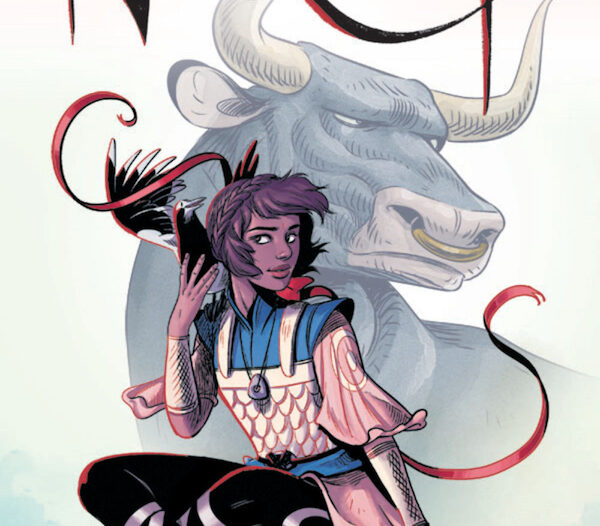
Review: ‘Norroway Book 1: The Black Bull of Norroway’

Norroway Book 1: The Black Bull of Norroway
Writer: Cat Seaton
Artist: Kit Seaton
Image Comics; $14.99
Rated T for Teen
Viewed from a particular distance, it is readily apparent that Norroway, a fantasy graphic novel series from the sibling team of Cat and Kit Seaton, is inspired by an old European fairy tale. It opens with three sisters visiting a witch to have their fortunes told, and she tells them each who they will marry—our hero is the youngest daughter, and she is told that she will marry a terrible beast.
The beast—a huge black bull—eventually arrives to claim her, and his fearsome current state turns out to be the product of a curse that transformed him and his siblings and their court, a curse he’s trying to break without being terribly forthcoming to his betrothed. At one point when she gets hungry, she finds she can pull a loaf of bread from one of his ears, a wine skin from the other, and he has coins in his mouth.
ADVERTISEMENT
ADVERTISEMENT
There’s a mountain of jagged glass. Specific, important instructions along the lines of “don’t leave this spot, or something dreadful will happen.” A woman is punished by having to wear red hot metal shoes.
In its broad plot outline and in some of these details and more, the Seatons’ Norroway evokes the sorts of fairy tales collected by the Brothers Grimm and Andrew Lang—in fact, Lang included “The Black Bull of Norroway” in The Blue Fairy Book, and it first showed up in 19th century collections of fairy tales from the British Isles.
But in the execution, Norroway feels fresh and vital, modern without being post-modern—although the bit where the bull spits up a wad of saliva-coated gold coins like a cat might spit up a hairball is a pretty solid gag. That’s all a long way of saying that while Norroway is based on an old Scottish fairy tale, it is an inspired extrapolation rather than an adaptation.
While many of the early scenes suggest pre-Industrial Europe and the traditions that bore its inspiration, the land of Norroway, the kingdom that the Bull and his siblings hail from, looks far more exotic, with costumes and architecture more inspired by ancient Mediterranean and North African cultures. It’s the sort of world-building based on a variety of real-world cultures that one can see in Faith Erin Hicks’ Nameless City, or in Avatar: The Last Airbender and its attendant comics adaptations.
Young Sibylla isn’t nearly as interested in marrying as her older sisters, and her initial question of the witch was whether or not she would ever get to ride on a ship, until her sister punches her in the arm. When she’s a grown-up, The Bull comes to her, and she rather gladly goes, as her only other marriage prospect is the goose boy, and riding on a giant bull is at least an adventure (She does get to ride on a ship to in this volume, but it’s not that great an experience for her).
ADVERTISEMENT
ADVERTISEMENT
Girl and bull are a predictable odd couple in the traditional Beauty and The Beast way, and it becomes clear from the outset that they are together because they have to be, according to the word of the witch: The Bull needs a wife in order to break his curse, Sibylla needs an adventure (In exchange for helping the bull, for example, she demands a sword).
First they visit his brother’s decrepit haunted castle, and then his sister’s beautiful but lonely castle, and then they travel so that the bull can fight a battle which will determine whether the curse can be broken or not. It is at this point that Sibylla is instructed not to move and, well, you can probably guess whether she does or not.
All along the way, snippets of conversation between the cursed siblings and those around them reveal clues about the curse, and Sibylla and the bull’s role in breaking it, but no one gives her a straight answer, and there seem to be arguments among them about what happened between them all.
The precise “rules” of their quest make for one of the points of tension in the story, along with the growing fondness between the two lead characters.
Based on a classic—if obscure—fairy tale, starring a plucky young heroine more interested in adventure than in finding her prince, featuring an animal sidekick of sorts in her pet magpie, and drawn in a style that seems a compromise between animation and realism, Norroway reads a bit like a Disney film as it might be in one of its earliest drafts, before being re-written and and re-written until it’s more focus-group friendly.
And all of that is just a long way of saying Norroway is really good, and you should check it out.
Filed under: Graphic Novels, Reviews, Young Adult
About J. Caleb Mozzocco
J. Caleb Mozzocco is a way-too-busy freelance writer who has written about comics for online and print venues for a rather long time now. He currently contributes to Comic Book Resources' Robot 6 blog and ComicsAlliance, and maintains his own daily-ish blog at EveryDayIsLikeWednesday.blogspot.com. He lives in northeast Ohio, where he works as a circulation clerk at a public library by day.
ADVERTISEMENT
ADVERTISEMENT
SLJ Blog Network
The Moral Dilemma of THE MONSTER AT THE END OF THIS BOOK
Cover Reveal and Q&A: The One and Only Googoosh with Azadeh Westergaard
Parsing Religion in Public Schools
ADVERTISEMENT







